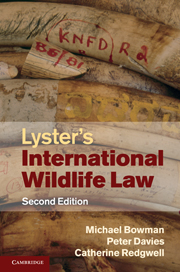Book contents
- Frontmatter
- Contents
- Foreword
- Preface
- List of abbreviations
- PART I Foundations of international wildlife law
- PART II Species regulation
- PART III Regional wildlife regulation
- PART IV Global wildlife regulation
- PART V Biological diversity: a new perspective on wildlife regulation
- PART VI Cross-sectoral issues in wildlife regulation
- 19 Wildlife and trade
- 20 Wildlife and welfare
- 21 Wildlife and pollution
- PART VII Conclusion
- Index
- References
21 - Wildlife and pollution
Published online by Cambridge University Press: 05 July 2011
- Frontmatter
- Contents
- Foreword
- Preface
- List of abbreviations
- PART I Foundations of international wildlife law
- PART II Species regulation
- PART III Regional wildlife regulation
- PART IV Global wildlife regulation
- PART V Biological diversity: a new perspective on wildlife regulation
- PART VI Cross-sectoral issues in wildlife regulation
- 19 Wildlife and trade
- 20 Wildlife and welfare
- 21 Wildlife and pollution
- PART VII Conclusion
- Index
- References
Summary
Background
The impact of pollution on wildlife is all too apparent. Many coral reefs have, for example, suffered from bleaching due to increases in seawater temperatures as a result of climate change. Additionally, the impact of oil pollution on the marine environment is potentially dramatic as shown by numerous high-profile oil pollution instances since the Torrey Canyon spill in 1967. More recently, the impact of anthropogenic noise sources on marine wildlife has been raised as a particular concern. Whilst international legal regimes designed specifically to protect wildlife and related ecosystems understandably provide the focus of this book, it is also important to appreciate that these regimes form just a part of the body of laws that make up international environmental law. International rules directly pertaining to wildlife conservation should not be regarded as acting in isolation from other international environmental treaty regimes. Regimes not specifically designed to conserve wildlife, but instead to prevent, minimise and eliminate pollution, also have an important part to play in the conservation of fauna, flora and associated habitats. This chapter provides examples of some of the key forms of pollution which threaten biodiversity, without aiming to be totally comprehensive in coverage. A brief introduction will also be provided to some of the most important treaties established to address these pollutants. The initial focus of discussion in this chapter is the significant threat posed by climate change, followed by the consequences of ozone layer depletion, acid precipitation and oil pollution.
- Type
- Chapter
- Information
- Lyster's International Wildlife Law , pp. 700 - 716Publisher: Cambridge University PressPrint publication year: 2010



